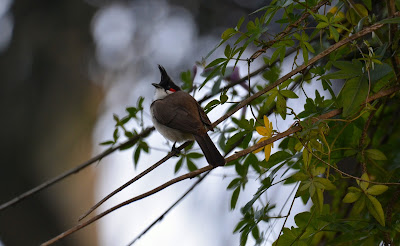I must’ve been in high school when I was first presented with my very own copy of Jim Corbett’s book, “The Temple Tiger and Man-Eaters of Kumaon.” I devoured the pages in no time, and soon, hungered for more. My love affair with the jungles of India had begun. Corbett followed Rudyard Kipling, Kenneth Anderson, Valmik Thapar, and the list grew lengthier by the day. Little did I know back then, that someday I’d tour these incredible jungles with a camera in hand and a wild imagination in tow, looking for a good picture or a subject for an article. Until then, my imagination was peppered with thoughts of tigers stalking unsuspecting deer, herds of gaur grazing peacefully, of leopards leaping from one branch to another, and of crocodiles slinking into the murky depths of a vast river.
 |
| Jungle fowl engaged in a spat |
Today, as I listen to the alarm calls of a spotted deer, sitting patiently in a safari jeep, I consider myself to be one of the fortunate few whose dream of capturing these memories on camera has finally come alive. A huge credit for this goes to the conservationists, forest department personnel, and all those who’ve battled for the protection and preservation of Indian jungles and its wildlife, making it possible for the likes of me to enjoy what remains of the flora and fauna in modern India.
The protection of endangered species and the forest cover is an ongoing battle, one that must be fought relentlessly at all times so that the generation after us isn’t relegated to photographing animals and birds at the zoo. Before the former Prime Minister Indira Gandhi launched Project Tiger in 1973, the population of these striped cats was on a rapid decline. By 1971, it is believed that a mere 1800 tigers remained in the wild. The demand was such that tiger skins adorned the living rooms of bureaucrats, nawabs and the elite of India and abroad. It wasn’t just the taxidermists who had a field day, but also poachers who hunted and sold various body parts of tigers, monitor lizards and elephants, and a host of other species, to anyone willing to buy them. From marketing them as powerful aphrodisiacs to talismans, 19th century India saw a vulgar display of wild animal body parts as ornamental pieces.
 |
| An elephant herd by the banks of Kabini |
Over the years, having toured numerous jungles across the sub-continent and read innumerable books on wildlife in India, I have come to the conclusion it isn’t all black and white as far as wildlife conservation is concerned. On one end of the spectrum are the experts who raise awareness and invest their heart and soul in the protection of critical species, and on the other end are the hapless villagers and tribal people who’ve lost crops, livestock, their homes and in some cases, lives to wild animals. Caught in the crossfire is the Forest Department whose main purpose today has become to strike a balance between the two.
 |
| A leopard in Nagarahole National Park |
What then is the future of wildlife in India? Are we doing enough to put an end to forest degradation and wildlife protection? A small, but crucial, part of the answer lies in Wildlife Tourism. Thapar, who invested over 35 years of his life battling for the protection of Tigers in India, said that the future of Indian wildlife lies in Wildlife Tourism. For many, wildlife tourism may be a double-edged sword, a matter of debate... but I couldn’t agree more. When I think of the future of wildlife in India, I not only envision a thriving tiger and leopard population, but also a healthy percentage of endangered species such as the Barasingha, Black Buck, and larger mammals including elephants and gaur, living unmolested by man. To make this possible, it’s imperative that we protect their homes and ensure they have enough space to establish territories. I emphasize on the importance of territorial space, because animals, especially predators, in most cases are territorial. In the case of elephants, they are creatures of habit, migrating from one part of the forest to another, looking for food and water. As for tigers, the lack of territorial space means an increased risk of human-animal conflict. Simply declaring tigers as protected will not suffice. A sustainable and practical future for these animals starts with prevention of forest degradation and establishing critical animal corridors. All of this boils down to responsible wildlife tourism. For the jungles of tomorrow, the India of today needs to educate the generation of the future. We need to teach them to revere the jungles, love and respect our wildlife. I believe that the foundation has been set by our predecessors who dedicated their lives for preservation and protection of wildlife in India. I’m optimistic that the day is not far when the jungles as I envision them, will become a reality.

